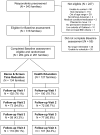A randomized controlled trial of culturally tailored dance and reducing screen time to prevent weight gain in low-income African American girls: Stanford GEMS
- PMID: 21041592
- PMCID: PMC3763243
- DOI: 10.1001/archpediatrics.2010.197
A randomized controlled trial of culturally tailored dance and reducing screen time to prevent weight gain in low-income African American girls: Stanford GEMS
Abstract
Objective: To test a 2-year community- and family-based obesity prevention program for low-income African American girls: Stanford GEMS (Girls' health Enrichment Multi-site Studies).
Design: Randomized controlled trial with follow-up measures scheduled at 6, 12, 18, and 24 months.
Setting: Low-income areas of Oakland, California.
Participants: African American girls aged 8 to 10 years (N=261) and their parents or guardians.
Interventions: Families were randomized to one of two 2-year, culturally tailored interventions: (1) after-school hip-hop, African, and step dance classes and a home/family-based intervention to reduce screen media use or (2) information-based health education.
Main outcome measure: Changes in body mass index (BMI).
Results: Changes in BMI did not differ between groups (adjusted mean difference [95% confidence interval] = 0.04 [-0.18 to 0.27] per year). Among secondary outcomes, fasting total cholesterol level (adjusted mean difference, -3.49 [95% confidence interval, -5.28 to -1.70] mg/dL per year), low-density lipoprotein cholesterol level (-3.02 [-4.74 to -1.31] mg/dL per year), incidence of hyperinsulinemia (relative risk, 0.35 [0.13 to 0.93]), and depressive symptoms (-0.21 [-0.42 to -0.001] per year) decreased more among girls in the dance and screen time reduction intervention. In exploratory moderator analysis, the dance and screen time reduction intervention slowed BMI gain more than health education among girls who watched more television at baseline (P = .02) and/or those whose parents or guardians were unmarried (P = .01).
Conclusions: A culturally tailored after-school dance and screen time reduction intervention for low-income, preadolescent African American girls did not significantly reduce BMI gain compared with health education but did produce potentially clinically important reductions in lipid levels, hyperinsulinemia, and depressive symptoms. There was also evidence for greater effectiveness in high-risk subgroups of girls.
Trial registration: ClinicalTrials.gov NCT00000615.
Figures




Comment in
-
Pediatric obesity prevention initiatives: more questions than answers.Arch Pediatr Adolesc Med. 2010 Nov;164(11):1067-9. doi: 10.1001/archpediatrics.2010.186. Arch Pediatr Adolesc Med. 2010. PMID: 21041601 No abstract available.
-
A programme of culturally tailored dance plus an intervention to reduce screen media use does not reduce BMI over 2 years compared with health education in preadolescent low-income African American girls but does reduce depressive symptoms and lipid levels.Evid Based Med. 2011 Jun;16(3):84-5. doi: 10.1136/ebm1191. Epub 2011 Mar 8. Evid Based Med. 2011. PMID: 21386117 No abstract available.
References
-
- Troiano RP, Flegal KM. Overweight children and adolescents: description, epidemiology, and demographics. Pediatrics. 1998;101:497–504. - PubMed
-
- Hedley A, Ogden CL, Johnson CL, Carrol MD, Curtin LR, Flegal KM. Prevalence of overweight and obesity among U.S. Children, adolescents, and adults, 1999–2002. JAMA. 2004;291:2847–2850. - PubMed
-
- Ogden CL, Carroll MD, Flegal KM. High body mass index for age among US children and adolescents, 2003–2006. JAMA. 2008;299:2401–2405. - PubMed
-
- Winkleby MA, Robinson TN, Sundquist J, Kraemer HC. Ethnic variation in cardiovascular disease risk factors among children and young adults: Findings from the Third National Health and Nutrition Examination Survey, 1988–1994. JAMA. 1999;281(11):1006–1013. - PubMed
-
- Resnicow K, Robinson TN. School-based cardiovascular disease prevention studies: review and synthesis. Ann Epidemiol. 1997;S7:S14–S31.
Publication types
MeSH terms
Substances
Associated data
Grants and funding
LinkOut - more resources
Full Text Sources
Medical
Miscellaneous

